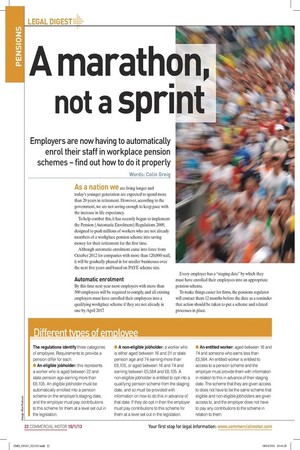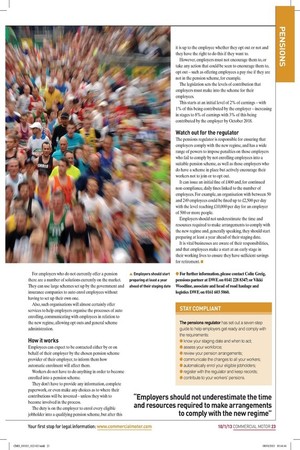A marathon, Employers are now having to automatica
Page 16

Page 17

If you've noticed an error in this article please click here to report it so we can fix it.
A marathon, Employers are now having to automatically enrol their staff in workplace pension schemes - find out how to do it properly „It woras: uoun breig As a nation we are living longer and today's younger generation are expected to spend more than 20 years in retirement. However, according to the government, we are not saving enough to keep pace with the increase in life expectancy.
To help combat this, it has recently begun to implement the Pension (Automatic Enrolment) Regulations 2009, designed to push millions of workers who are not already members of a workplace pension scheme into saving money for their retirement for the first time.
Although automatic enrolment came into force from October 2012 for companies with more than 120,000 staff, it will be gradually phased in for smaller businesses over the next five years and based on PAYE scheme size.
Automatic enrolment By this time next year most employers with more than 500 employees will be required to comply, and all existing employers must have enrolled their employees into a qualifying workplace scheme if they are not already in one by April 2017 Every employer has a "staging date" by which they must have enrolled their employees into an appropriate pension scheme.
To make things easier for firms, the pensions regulator will contact them 12 months before the date as a reminder that action should be taken to put a scheme and related processes in place.
For employers who do not currently offer a pension there are a number of solutions currently on the market. They can use large schemes set up by the government and insurance companies to auto enrol employees without having to set up their own one.
Also, such organisations will almost certainly offer services to help employers organise the processes of auto enrolling, communicating with employees in relation to the new regime, allowing opt outs and general scheme administration.
How it works Employees can expect to be contacted either by or on behalf of their employer by the chosen pension scheme provider of their employer, to inform them how automatic enrolment will affect them.
Workers do not have to do anything in order to become enrolled into a pension scheme.
They don't have to provide any information, complete paperwork, or even make any choices as to where their contributions will be invested — unless they wish to become involved in the process.
The duty is on the employer to enrol every eligible jobholder into a qualifying pension scheme, but after this it is up to the employee whether they opt out or not and they have the right to do this if they want to.
However, employers must not encourage them to, or take any action that could be seen to encourage them to, opt out — such as offering employees a pay rise if they are not in the pension scheme, for example.
The legislation sets the levels of contribution that employers must make into the scheme for their employees.
This starts at an initial level of 2% of earnings — with 1% of this being contributed by the employer — increasing in stages to 8% of earnings with 3% of this being contributed by the employer by October 2018.
Watch out for the regulator The pensions regulator is responsible for ensuring that employers comply with the new regime, and has a wide range of powers to impose penalties on those employers who fail to comply by not enrolling employees into a suitable pension scheme, as well as those employers who do have a scheme in place but actively encourage their workers not to join or to opt out.
It can issue an initial fine of £400 and, for continued non-compliance, daily fines linked to the number of employees. For example, an organisation with between 50 and 249 employees could be fined up to £2,500 per day with the level reaching £10,000 per day for an employer of 500 or more people.
Employers should not underestimate the time and resources required to make arrangements to comply with the new regime and, generally speaking, they should start preparing at least a year ahead of their staging date.
It is vital businesses are aware of their responsibilities, and that employees make a start at an early stage in their working lives to ensure they have sufficient savings for retirement. • Diff-r-nt 9of -mils -- The regulations identify three categories of employee. Requirements to provide a pension differ for each.
• An eligible jobholder: this represents a worker who is aged between 22 and state pension age earning more than £8,105. An eligible jobholder must be automatically enrolled into a pension scheme on the employer's staging date, and the employer must pay contributions to this scheme for them at a level set out in the legislation.
• A non-eligible jobholder: a worker who is either aged between 16 and 21 or state pension age and 74 earning more than £8,105, or aged between 16 and 74 and earning between £5,564 and £8,105. A non-eligible jobholder is entitled to opt into a qualifying pension scheme from the staging date, and so must be provided with information on how to do this in advance of that date. If they do opt in then the employer must pay contributions to this scheme for them at a level set out in the legislation.
• An entitled worker: aged between 16 and 74 and someone who earns less than £5,564. An entitled worker is entitled to access to a pension scheme and the employer must provide them with information in relation to this in advance of their staging date. The scheme that they are given access to does not have to be the same scheme that eligible and non-eligible jobholders are given access to, and the employer does not have to pay any contributions to the scheme in relation to them.
STAY COMPLIANT The pensions regulator has set out a seven-step guide to help employers get ready and comply with the requirements: • know your staging date and when to act; • assess your workforce; • review your pension arrangements; • communicate the changes to all your workers; • automatically enrol your eligible jobholders; • register with the regulator and keep records; • contribute to your workers' pensions.
Employers should start • For further information, please contact Colin Greig, preparing at least a year pensions partner at DWF, on 0141 228 8347; or Vikki ahead of their staging date Woodfine, associate and head of road haulage and logistics DWF, on 0161 603 5060.









































